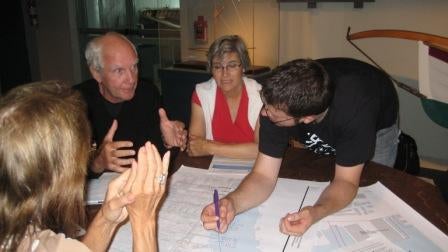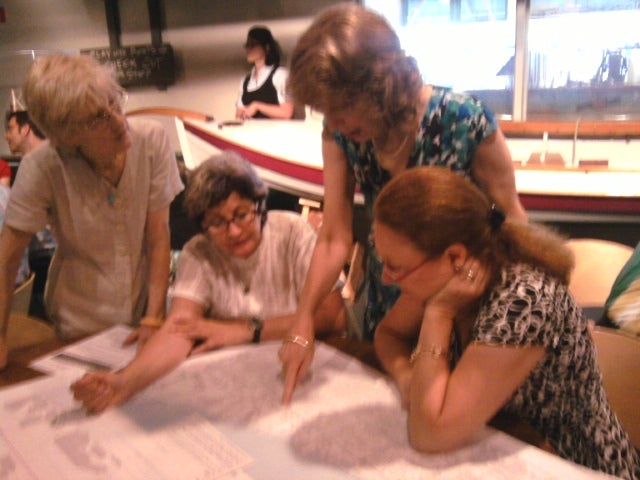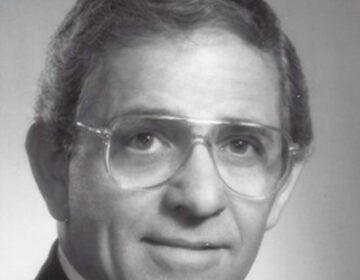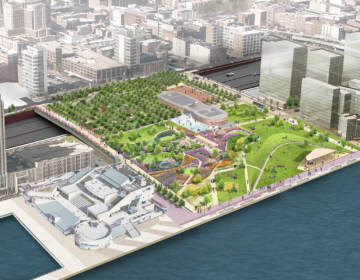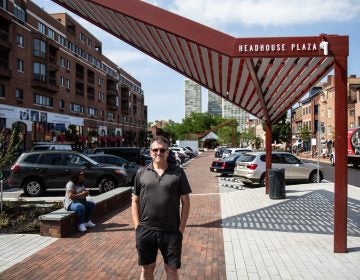Planners get residents’ ideas for Central Delaware makeover
A trolley that travels down Washington Avenue from Broad Street to the Delaware River; low-rise, densely built residences; restaurants and shops tucked beneath I-95.
These are just a few of the many ideas for the southern half of the Central Delaware waterfront voiced Thursday night by the about 35 people who came to a public input meeting hosted by the Central Delaware Advocacy Group with assistance from the Delaware Riverfront Waterfront Corporation.
Input gleaned from Thursday’s meeting – and a similar one on Monday night that will focus on the northern portion of the Central Delaware – will be delivered to the team of consultants that is putting together the Master Plan for the Central Delaware, a document designed to guide riverfront revitalization in this city for decades to come.
“I’m excited tonight because we are just about to see, and have input on, and start really to work on some of the flesh and bone parts of the master plan,” said CDAG Chairman Steve Weixler. The effort is now about turning the public’s vision for the section of riverfront between Allegheny and Oregon Avenues and turning it into “something buildable,” he said.
The master planning consultants, led by Alex Cooper of Cooper Robertson & Partners, have been at their work since February. They spent the first four months gathering information on the 1,100 acres that sit between Allegheny and Oregon Aves., the river and I-95, and on June 7 presented their preliminary observations.
The information they received from Thursday’s session as well as the Monday meeting will help the planners as they create a number of different alternatives that will be presented to the public on Sept. 22 at Festival Pier, said DRWC President Tom Corcoran. The alternatives presentation will be something like what was done when three options were presented for the Race Street Pier design, Corcoran said. And similarly to that process, the public will provide feedback on which option or options it favors at the September meeting. Based on that input, the planners will finish their work, with hopes of presenting the final plan in January 2011, Corcoran said.
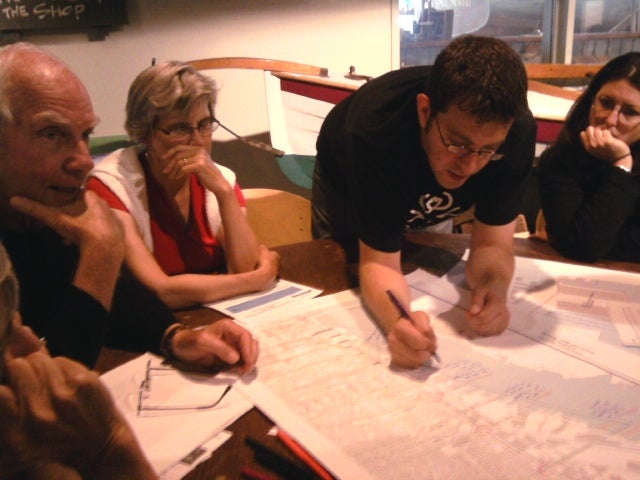
The master plan team has already identified “three places that really require a lot of study, that will be springboards to connect the whole waterfront,” Corcoran said. These locations are Washington Avenue at Columbus Boulevard, the site which Thursday’s crowd put extra focus on; the Festival Pier site at the foot of Spring Garden Street, which will get special attention Monday night; and Penn’s Landing.
Determining what to do at Penn’s Landing will require public input, too, Corcoran said. But the team isn’t ready for it yet. “We are still working with transportation planners to get a handle on the geometry of the site, and on previous engineering work” that has been done. Over the past 35 years, there have been nine different plans to improve Penn’s Landing, Corcoran said. “It’s going to take us awhile to get our arms around that animal.”
The planners are also taking a close look at transportation and traffic planning, Corcoran said. They are determining what traffic counts are like today, he said. When the master plan yields future use goals for the waterfront and adjacent neighborhoods, the planners will need to determine what “types of mitigation and traffic controls will need to be in place so the built-out waterfront will work well,” Corcoran said.
For more information, see the Central Delaware Master Plan website which is updated several times a week, blog-style, said Master Plan Coordinator Sarah Thorp.
With the outlines drawn, facilitator Jennifer Hurley of the Hurley-Franks & Associates planning and urban design firm put participants to work.
Seated in small groups that swapped members throughout the evening so that everyone could see what everyone else was thinking, participants were given street maps of the Central Delaware and asked to write on them their ideas for improving streets and transportation and for adding open space.
Then they were asked to specifically focus on the area around Columbus Boulevard and Washington Avenue in South Philadelphia. Facilitators handed out a stack of photographs showing shots of neighborhoods with different development styles and feel, and participants were told to record the elements they thought they would like to see at Columbus and Washington and those they wanted no part of.
One table concluded that the area around Tasker Avenue needed some help. “Traffic backs up there, and it is a desolate area,” said Caryn Hunt. Norma Van Dyke said she has no car, and walking near Tasker is uncomfortable now because it is “very trashy and desolate.” The group also recommended extending Tasker Avenue to the new bike trail.

At another table, Harry Schwartz lobbied to re-do the Washington Avenue overpass of I-95 so that there was room for commercial activity, and to put lighting under the aised highway that would make the place safer and more attractive. He was especially enamored with the idea of an ice cream parlor, but any destinations that would bring people would be great, he said.
David Famiano said he walked from his home near Broad and Ellsworth in South Philadelphia to the meeting, which was held at Independence Seaport Museum. But he got himself to Market Street before heading to the riverfront. Underpasses just don’t seem inviting or safe, he said. So he went to a bridge instead.Famiano also suggested creating a trolley that would zoom along Washington Avenue from Broad to the river, which would allow a trolley-subway connection.
Marsha Moss said that artists could do wonderful things with the pier remnants that jut up out of the water periodically. When it comes to open space, she suggested punctuating the Central Delaware with a series of small, green spaces.
Weixler said the Great Plaza at Penn’s Landing needs a serious overhaul.Trees and green space would be a good start, he said. “People go to the Great Plaza to attend something, they don’t ever go there just to be there,” he said. After the meeting, Famiano had another suggestion for the planners. Famiano, who is in his 30s, said that a special effort should be made to get more people in their 20s and 30s participating in these public input sessions. The master plan is such a long-term project, he said, that when it comes to the revitalized waterfront, “we’re the ones who will be using it in 20 or 30 years.”
Reach the reporter at kgates@planphilly.com.
WHYY is your source for fact-based, in-depth journalism and information. As a nonprofit organization, we rely on financial support from readers like you. Please give today.



